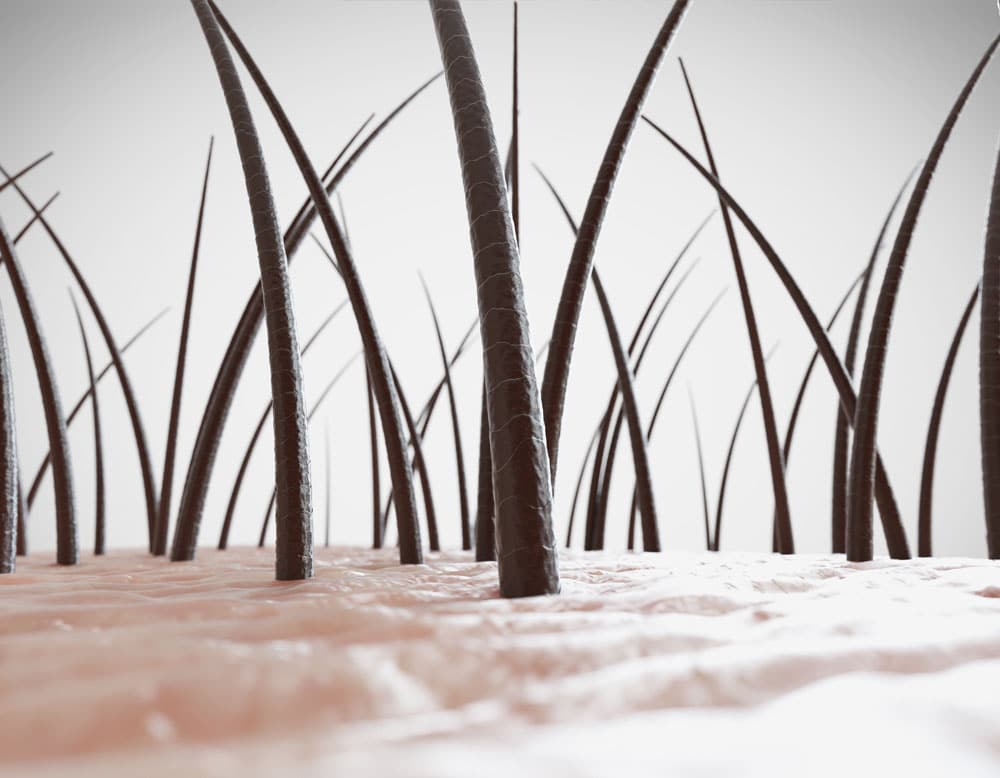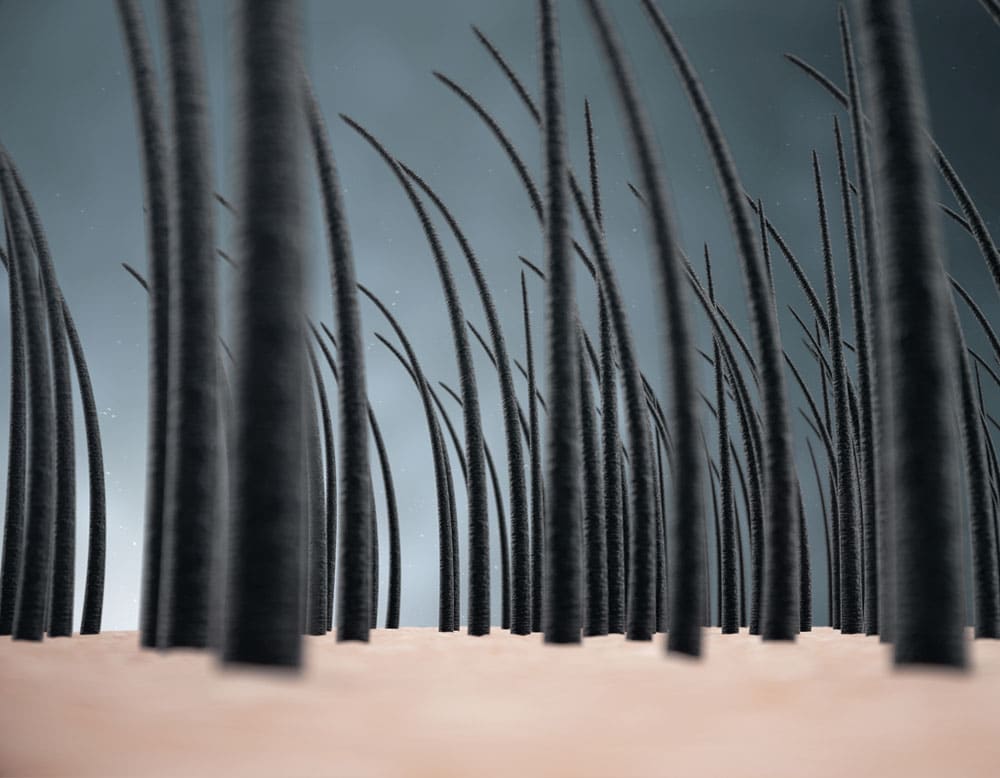How do hair follicles work?
Hair follicles are small, pocket-like holes in our skin. As the name suggests, they grow hair. According to the American Academy of Dermatology the average person has about 100,000 hair follicles on the scalp alone . We will look at what hair follicles are and how they grow hair.

Anatomy of a follicle
A hair follicle is a tunnel-shaped structure in the epidermis (outer layer) of the skin. Hair begins to grow at the base of a hair follicle. The hair root consists of protein cells and is nourished by blood from nearby blood vessels.
As more cells are produced, the hair grows out of the skin and reaches the surface. Sebaceous glands near the hair follicles produce oil that nourishes the hair and skin.
Hair growth cycle
The hair grows out of the follicles in cycles. There are three different phases of this cycle:
- Anagen (growth) phase The hair starts to grow from the root. This phase usually lasts between three and seven years.
- Catagen (transition) phase Growth slows down and the follicle shrinks during this phase. This lasts between two and four months.
- Telogen (rest) phase The old hair falls out and new hair starts to grow from the same hair follicle. This takes between three and four months.
After a Article 2015 Recent research has shown that hair follicles do not only "rest" during the telogen phase. During this phase, a lot of cellular activity takes place so that the tissue can regenerate and grow more hair. In other words, the telogen phase is crucial for the formation of healthy hair.
Different follicles go through different phases of the cycle at the same time. Some follicles are in the growth phase while others may be in the resting phase. Some of your hairs may grow while others fall out.
According to the American Osteopathic College of Dermatology the average person loses about 100 strands of hair per day. Over 90 percent of your hair follicles are in the anagen phase at any given time.
The life of a follicle
On average, your hair grows about 1.2 cm every month. Your hair growth rate can be affected by your age, hair type and general health.
Hair follicles are not only responsible for how much your hair grows, they also influence how your hair looks. The shape of your follicle determines how curly your hair is. Circular follicles produce straight hair, while oval follicles produce curlier hair.
Hair follicles also play a role in determining the colour of your hair. Like skin, your hair gets its pigment from the presence of melanin. There are two types of melanin: eumelanin and pheomelanin.
Your genes determine whether you have eumelanin or pheomelanin and how much of each pigment you have. An abundance of eumelanin makes hair black, a moderate amount of eumelanin makes hair brown and very little eumelanin makes hair blond. Phaeomelanin, on the other hand, makes the hair red.
This melanin is stored in hair follicle cells, which then determine hair colour. Your follicles may lose their ability to produce melanin as you age, leading to the growth of grey or white hair.
When hairs are pulled out of the hair follicle, they can grow back. It is possible for a damaged follicle to stop producing hair. Certain conditions such as alopecia can cause follicles to stop producing hair altogether.
Problems with hair follicles

A number of hair conditions are caused by problems with hair follicles. If you think you have a hair condition, or if you have unexplained symptoms such as hair loss, it is best to consult a dermatologist.
Androgenetic alopecia
Androgenetic alopecia, known as male pattern hair loss in men, is a condition that affects the growth cycle of hair follicles on the scalp. The hair cycle slows down and weakens, eventually coming to a complete stop. This results in the follicles not producing new hair.
According to the US National Library of Medicine, androgenetic alopecia affects 50 million men and 30 million women.
Alopecia areata
Alopecia areata is an autoimmune disease. The immune system mistakes the hair follicles for foreign cells and attacks them. It often causes hair to fall out in clumps. It can lead to alopecia universalis, which is total hair loss all over the body.
There is still no known cure for Alopecia areatabut steroid injections or topical treatments can slow down hair loss.
Folliculitis
Folliculitis is an inflammation of the hair follicles. It can occur anywhere hair grows, including yours:
- Scalp
- Legs
- Armpits
- Face
- Weapons
Folliculitis often looks like a rash of small bumps on your skin. The bumps can be red, white or yellow and contain pus. Often folliculitis is itchy and sore.
Folliculitis is often caused by a staph infection . Folliculitis can go away without treatment, but a doctor can diagnose you and give you medication to treat it. This may include topical treatments or oral medications to treat the cause of the infection and relieve the symptoms.
Telogen effluvium
Telogen effluvi around a temporary but common form of hair loss. A stressful event causes hair follicles to enter the telogen phase prematurely. This causes the hair to thin and fall out.
The hair often falls out in patches on the scalp, but in extreme cases it can fall out in other parts of the body, including the legs, eyebrows and pubic area.
The Stress can be caused by:
- a physically traumatic event
- Birth
- a new drug
- Surgery
- Disease
- a stressful life change
The shock of the event triggers the change in the hair growth cycle.
Telogen effluvium is usually temporary and does not require treatment. However, it is best to speak to a dermatologist if you think you have telogen effluvium as they will need to rule out other causes.
Hair regrowth
If you suffer from conditions such as alopecia or baldness, you may wonder if it is possible to stimulate a hair follicle to regrow hair.
If a follicle has been damaged, it cannot be restimulated. At least we don't know how to restimulate it yet.
However, some new stem cell research gives hope. In one Article 2017 found a new method to reactivate dead or damaged hair follicles. However, this treatment has not yet been tested on humans and has not been approved by the Food and Drug Administration (FDA).
Can hair growth products accelerate hair growth?
Hair Growth Serum without prescription can actually support healthy hair growth to promote. Also Hair transplants have recently become very fashionable, but there are some factors to consider: 10 to 80 per cent of transplanted hair grows back completely in an estimated three to four months. Like normal hair, transplanted hair thins over time.
Summary
Your hair follicles are responsible for hair growth, which occurs in cycles of three different phases. These follicles also determine your hair type.
If they are damaged, the follicles may stop producing hair and your hair growth cycle may slow down. If you have concerns about your hair growth, consult a dermatologist.
Questions and answers
Do hair follicles grow back when they are pulled out?
Finally, pulled hair does not grow back. Repeated hair pulling has been shown to damage hair follicles. Because trichotillomania causes repeated hair pulling, damaged follicles can often result. If enough hairs are pulled out, these damaged hair follicles can affect hair regrowth.
Are hair follicles dying?
A follicle is essentially a sac lined with cells from which strands of hair grow. ... But if hair follicles don't get enough nourishment, they can die. They just get thinner and thinner until they eventually fall off our heads. When this happens, our scalp loses hair and we see baldness.
Can hair follicles become inflamed?
Hair folliculitis or folliculitis is a common skin condition in which hair follicles become inflamed. It is usually caused by a bacterial or fungal infection. At first glance, it may look like small red bumps or white-headed pimples around the hair follicles - the tiny pockets from which each hair grows.
What makes hair follicles grow?
Your hair starts to grow from a root in the lower part of the follicle. The root consists of protein cells. Blood from the blood vessels in your scalp feeds the root, creating more cells and allowing the hair to grow. The hair is pushed through the skin as it grows, passing through an oil gland. You can also Hair Growth Serum use to support healthy hair growth.